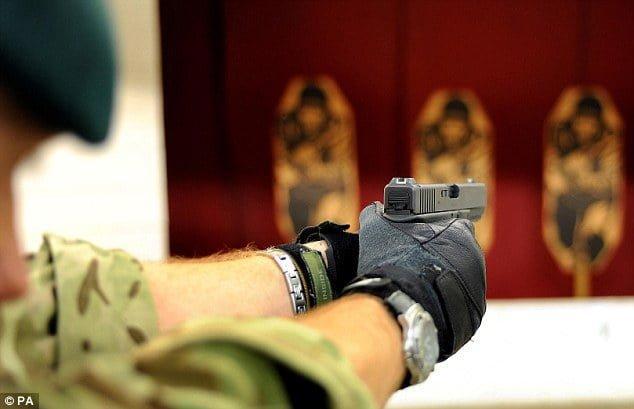Guns with short barrels, small magazines, and subcompacts are meant for those who favor carry-ability over firepower and range. The Glock 26, referred to by the company itself as the “Baby Glock,” is a compact weapon that can carry as much ammunition as full-sized nine-millimeter handguns.
Baby Glock
The Glock 26 trades magazine capacity for compactness. But it does have the ability to gain back that firepower at the expense of carry-ability if the user so wishes. The “Baby Glock” G26 will also take the Glock 19’s fifteen-round magazine, the Glock 17’s seventeen-round magazine, and even Glock’s submachine gun-sized thirty-three-round stick magazine without modification.
One of the most competitive markets in handguns is the subcompact market.
Guns with short barrels, small magazines, and subcompacts are meant for those who favor carry-ability over firepower and range. The Glock 26, referred to by the company itself as the “Baby Glock,” is a compact weapon that can carry as much ammunition as full-sized nine-millimeter handguns.
The Glock 26 was released in 1994 and was designed from the outset for home defense, law enforcement, and concealed-carry weapons. The subcompact Glock 26 followed up on the compact Glock 19, which, in turn, was a smaller version of the original Glock 17. Glock simultaneously improved the overall design with each iteration and made it smaller and more useful to concealed carriers and those who needed a discrete handgun.
Glock 17 vs. Glock 26
A comparison between the Glock 17 and Glock 26 is illustrative. Both are nine-millimeter Luger handguns, and they both use the same striker-fired operating system, known as “Safe Action.” The company designed the gun’s three internal safeties so that the gun owner must disengage them to fire the weapon. Both have the same 5.5-pound trigger pull with half-inch trigger travel. At 1.18 inches, both guns are even the same width. All of this is important as it allows new or existing gun users to pick up a larger Glock 17 (or Glock 19) as a first gun and then purchase a smaller Glock 26 without learning the ins and outs of a new firearm. From manual operation to feel, the Glock 26 is the same gun.

However, it is essential to note that the dimensions and ammunition capacity of the two guns diverge in separate—but equally applicable—directions. The Glock 26, at 6.41 inches, is more than an inch and a half shorter than the Glock 17. The Glock 26 weighs 21.71 ounces unloaded, a quarter-pound less than the Glock 17, and weighs even less loaded due to the smaller magazine. The Glock 26 takes a ten-round double-stack magazine, while the Glock 17 takes a seventeen-round magazine.
Magazine system
The Glock 26 magazine system is the largest and most versatile class. One competitor, the Smith & Wesson M&P Bodyguard, can store just six .380 caliber rounds. Another, the Beretta Nano, carries eight nine-millimeter Luger rounds. The Glock 26, on the other hand, takes ten nine-millimeter rounds in a double-stack magazine, all while remaining just over an inch wide and maintaining a relatively short grip. In keeping the grip short, the Glock 26 lacks a flared mag-well. (Some individuals find the Glock subcompact’s grip a little too short, and for them, there are inexpensive thirty-party grip extensions that provide a larger grip surface.)
The Glock 26 trades magazine capacity for compactness. But it does have the ability to gain back that firepower at the expense of carry-ability if the user so wishes. The “Baby Glock” G26 will also take the Glock 19’s fifteen-round magazine, the Glock 17’s seventeen-round magazine, and even Glock’s submachine gun-sized thirty-three-round stick magazine without modification.
Gen 5
Glock periodically pushes out new versions of its handguns, conservatively adding new features when they become available. In 2018, Glock introduced the Gen 5 Glock 26. The Gen 5 features the Glock Marksman Barrel with enhanced right-hand polygonal rifling and an improved barrel crown. The Gen 5 also includes a new dot pattern on the grip, backstrap, and front strap for a better hold, ambidextrous slide stops, and a new slide finish, called nDLC, for protection from corrosion and wear. Missing in the Gen 5 are finger grooves, which are redundant with the new grip pattern.
The Glock 26 is several handguns in one. It is a subcompact pistol with a larger than average magazine capacity at its core. Alternately, it is a handgun with a standard seventeen-round magazine capacity. Finally, it can be a thirty-three-round blaster for target plinking at the range. The “Baby Glock” isn’t just a contender for concealed carry enthusiasts. It’s also a viable option for everyone else as well.






I have owned a few dozen different Glocks, including some G26 models. My all time favorite pistol is a G19.
Just for fun, I once competed in an IPSC match using a G26. This was a ” valuable learning experience”. While was very comfortable shooting the G26 for short practice sessions, I noted a big reduction in my scores from when doing identical drills with my G19 and G17. Practice scores with a G19 and a G17 were actually quite close.
However, shooting an entire match with a G26, with several stages requiring a dozen rds or more, this reduction was even more noticeable. I found the too short grip of the G26 squirmed in my hand. On the high round count stages I was constantly re-establishing my grip, and my scores reflected the inconsistencies in grip.
I also found in practice that the G26 was overly sensitive to “limp wristing”, with failures to cycle unless a solid grip was used. Some weird shooting positions, especially one handed, created malfunctions. I also experimented with the extended 33 Rd magazines in the super short grip of the G26, and again malfunctions occurred as the longer magazine rocked away in the too short grip channel.
None of my G19 or G17 pistols experienced these types of malfunctiions. IMHO, based on my personal experience, the G26 is not as reliable as the larger models.
YPMMV.
I have never had a problem with my Glock 26. Each person will have their own story.